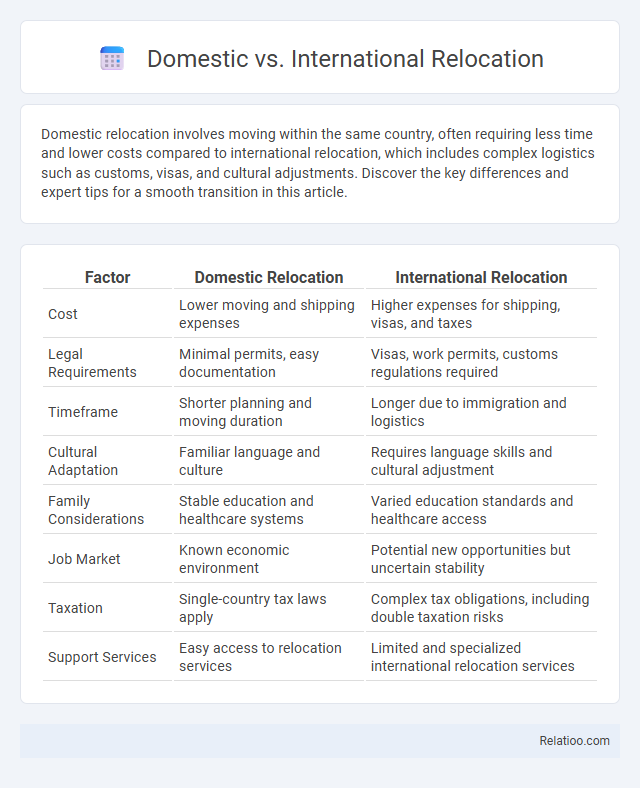Domestic relocation involves moving within the same country, often requiring less time and lower costs compared to international relocation, which includes complex logistics such as customs, visas, and cultural adjustments. Discover the key differences and expert tips for a smooth transition in this article.
Table of Comparison
| Factor | Domestic Relocation | International Relocation |
|---|---|---|
| Cost | Lower moving and shipping expenses | Higher expenses for shipping, visas, and taxes |
| Legal Requirements | Minimal permits, easy documentation | Visas, work permits, customs regulations required |
| Timeframe | Shorter planning and moving duration | Longer due to immigration and logistics |
| Cultural Adaptation | Familiar language and culture | Requires language skills and cultural adjustment |
| Family Considerations | Stable education and healthcare systems | Varied education standards and healthcare access |
| Job Market | Known economic environment | Potential new opportunities but uncertain stability |
| Taxation | Single-country tax laws apply | Complex tax obligations, including double taxation risks |
| Support Services | Easy access to relocation services | Limited and specialized international relocation services |
Understanding Domestic vs International Relocation
Understanding domestic vs international relocation involves recognizing key differences in scope, regulations, and logistics. Domestic relocation typically entails moving within the same country, requiring less complex legal documentation and lower costs, while international relocation involves navigating customs, visas, and cross-border transportation challenges. Effective planning for international relocation demands thorough research on immigration laws, cultural adjustments, and shipping regulations to ensure a smooth transition.
Key Differences Between Domestic and International Moves
Domestic relocation involves moving within the same country, often requiring less paperwork, shorter travel times, and fewer customs regulations, while international relocation demands handling visas, customs declarations, and longer transit durations. Your international move typically involves more extensive planning, higher costs, and coordination with global shipping and moving companies compared to domestic moves. Understanding these key differences helps streamline your relocation process by addressing legal, logistical, and cultural aspects unique to each type.
Cost Comparison: Domestic vs International Relocation
Domestic relocation generally costs significantly less than international relocation due to shorter distances, fewer regulatory complexities, and reduced transportation fees. International relocation expenses include customs duties, immigration fees, and higher shipping costs for household goods, making it substantially more expensive. Budgeting for international moves requires careful consideration of these additional costs to avoid unexpected financial burdens.
Legal and Documentation Requirements
Domestic relocation requires compliance with state or regional regulations, often involving utility transfers and change of address notifications without extensive legal paperwork. International relocation demands more complex legal documentation, including visas, work permits, customs declarations, and compliance with immigration laws. Relocation in general involves organizing necessary permits, ensuring adherence to housing agreements, and updating legal identification records to reflect the new residence.
Cultural Adjustments and Lifestyle Changes
Domestic relocation often involves fewer cultural adjustments and lifestyle changes compared to international relocation, as individuals typically remain within the same language and societal norms. International relocation requires managing significant cultural differences, language barriers, and adapting to new social customs, which can impact daily routines and social interactions. Both types of relocation demand flexibility, but international moves usually necessitate more comprehensive preparation for successful integration into the new environment.
Packing and Shipping Logistics
Domestic relocation involves simpler packing and shipping logistics due to shorter distances and fewer regulatory requirements. International relocation demands intricate packing strategies to protect belongings during long transit times and strict adherence to customs regulations, shipping schedules, and import/export documentation. Efficient coordination with specialized carriers and comprehensive insurance coverage is crucial to ensure secure and timely delivery in both relocation types.
Choosing the Right Relocation Services
Choosing the right relocation services requires understanding the distinct demands of domestic vs international relocation, with domestic moves prioritizing local expertise and faster transit times while international relocations demand customs knowledge, international insurance, and compliance with global regulations. Evaluating services based on their experience with specific relocation types, such as handling customs clearance for international moves or providing efficient packing and storage for domestic shifts, ensures a smoother transition. Cost, timing, and support options like visa assistance or local housing services also play crucial roles in selecting the optimal relocation provider tailored to individual or corporate needs.
Managing Stress During the Move
Managing stress during relocation involves different strategies for domestic, international, and general moves due to varying complexities. Domestic relocation often requires efficient time management and organization for packing and logistics within familiar legal and cultural environments, while international relocation demands extra attention to visa processes, customs regulations, and cultural adjustments. Effective stress management during any move includes creating detailed checklists, seeking professional moving assistance, and maintaining open communication with family or movers to reduce anxiety and ensure a smoother transition.
Preparing Family and Pets for Relocation
Preparing family and pets for relocation involves tailored strategies depending on whether the move is domestic or international. Domestic relocation usually requires organizing school transitions, updating medical records, and acclimating pets to new local environments. International relocation demands thorough research on customs regulations, securing pet vaccinations for international travel, and preparing family members for cultural adjustments and potential language barriers.
Final Checklist for a Successful Move
A final checklist for a successful move should include confirming all address changes, securing necessary permits, and verifying utility setups for both domestic and international relocations. Domestic moves need emphasis on local regulations and timely coordination with movers, while international relocations require additional focus on customs documentation and currency exchange arrangements. Proper planning of these elements ensures a smooth transition regardless of relocation type.

Infographic: Domestic vs International Relocation
 relatioo.com
relatioo.com